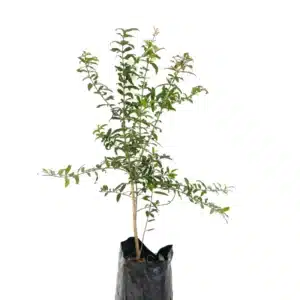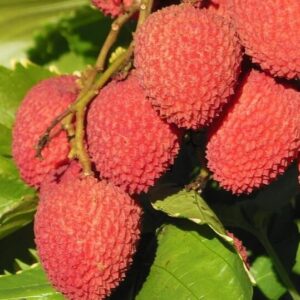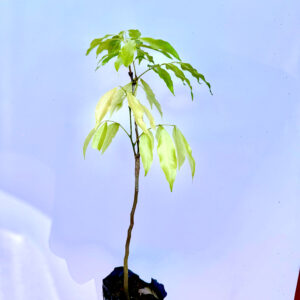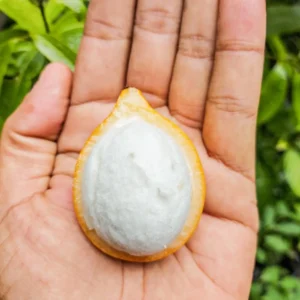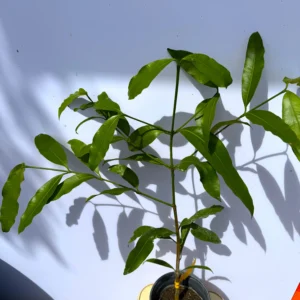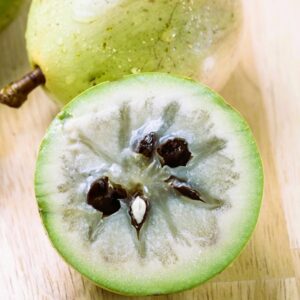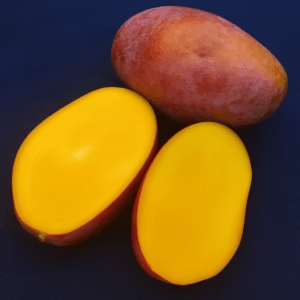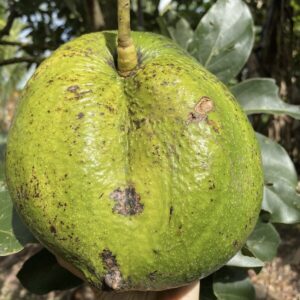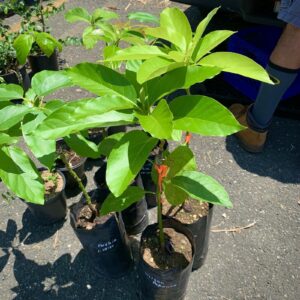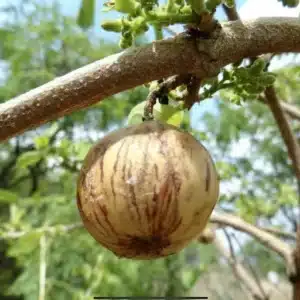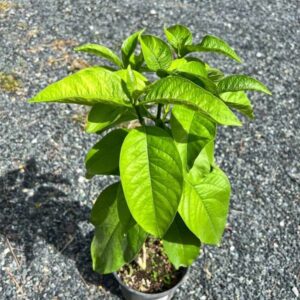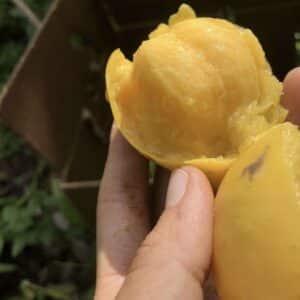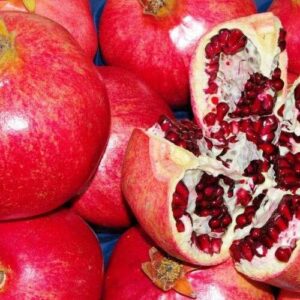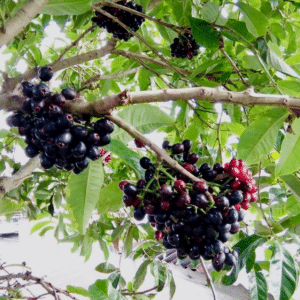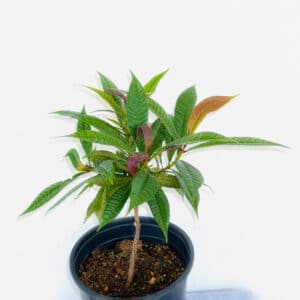Pomegranate Tropical Fruit Tree 24”-36”
Pomegranate is a fruit tree that is known for its striking appearance, with bright red fruit encasing juicy, ruby-colored seeds. The pomegranate tree is a drought-resistant plant that can grow up to 30 feet tall and wide, and can live for up to 200 years. In this description, we will discuss how to plant and care for a pomegranate tree, and some of the benefits it can provide. An interesting fact about pomegranates is that they have been revered throughout history for their medicinal properties. In ancient times, pomegranates were believed to have healing powers and were used to treat a variety of ailments, including infections, diarrhea, and even infertility. Modern research has shown that pomegranates are indeed a rich source of antioxidants and anti-inflammatory compounds, which may help to protect against chronic diseases such as heart disease and cancer. The juice of the pomegranate fruit has also been found to have antibacterial and antiviral properties, making it a valuable addition to a healthy diet.
The pomegranate tree (Punica granatum) is a versatile and rewarding plant that offers beauty, nutrition, and cultural significance. Its stunning flowers, hardy growth, and delicious fruits make it a favorite among gardeners and fruit enthusiasts alike. With proper care, including regular watering, fertilizing, and pruning, the pomegranate tree can thrive in a variety of climates and provide bountiful harvests for years to come. Whether grown for its ornamental appeal, culinary uses, or health benefits, the pomegranate tree is a timeless addition to any garden or orchard.
Grafted lychee tree (Litchi chinensis) tropical live tree 2′-3′ feet tall
The grafted lychee tree (Litchi chinensis) is a highly rewarding tropical fruit tree that offers early and consistent fruit production, attractive growth habit, and excellent fruit quality. With proper care, including regular watering, fertilization, pruning, and protection from cold, it can thrive in a variety of tropical and subtropical settings. Whether grown for fresh fruit, culinary use, or ornamental appeal, the grafted lychee tree is a valuable addition to home gardens and orchards.
Achacha (Garcinia humilis) exotic fruit tree 2′-3′ feet tall
Garcinia achachairu is a remarkable tropical fruit tree that combines ornamental appeal with high-quality, flavorful fruit. Its manageable size, drought tolerance, and minimal pest problems make it suitable for home gardens, small orchards, and urban farming projects. With proper care, including regular watering, fertilizing, and occasional pruning, the Achachairú tree can thrive and reward growers with abundant harvests of tangy, refreshing fruit. Whether grown for personal enjoyment or small-scale commercial purposes, this unique fruit tree is a valuable and rewarding addition to any tropical or subtropical landscape.
White Star Apple ( Chrysophyllum cainito) Caimito tropical live fruit tree 12″-24″
White Star Apple, scientifically known as Chrysophyllum cainito, is a tropical fruit tree prized for its sweet, juicy fruit and striking appearance. Native to the Caribbean and Central America, it has become widely cultivated in tropical and subtropical regions around the world. The tree is known for its glossy green leaves with a golden-brown underside and for producing round, smooth-skinned fruit with a star-shaped pattern inside when cut crosswise, giving it its common name. The white star apple is one of several varieties of Chrysophyllum cainito, with the white flesh offering a unique and refreshing taste compared to other varieties.
Grafted Avocado marcus (Persea americana) tropical live fruit tree 12”-24”
Marcus Pumpkin Variety Avocado (Persea americana). This unique avocado variety, known for its unusual shape and rich flavor, promises not only a delicious addition to your culinary endeavors but also the satisfaction of nurturing a thriving fruit tree.
Interesting Fact
The Marcus Pumpkin Variety Avocado is not only known for its unique appearance and delicious taste but also for its historical significance. This avocado variety has been cultivated for centuries, with roots tracing back to ancient civilizations in Central and South America. It was highly prized by indigenous cultures for its rich flavor and nutritional value. Today, it continues to be a symbol of tradition and a source of culinary delight, making it a valuable addition to any garden or orchard.
Spanish tamarind (vangueria madagascariensis) live fruit tree 12”-24” Irresistible
Vangueria madagascariensis, also known as Spanish Tamarind or Wild Medlar, is a tropical fruit tree native to Africa. It features an attractive, evergreen foliage with dark green, glossy leaves. The tree produces small, round fruits that ripen from green to yellow or orange when fully mature. Spanish Tamarind trees thrive in tropical and subtropical climates and require full sun to partial shade. With proper care, including regular watering, well-drained soil, and occasional fertilization, these trees can flourish and bear delicious fruits. The fruits are highly valued for their taste and are used in various culinary applications. In addition to its culinary uses, the Spanish Tamarind tree holds cultural significance in some African communities and is associated with spiritual beliefs and traditional ceremonies. Its ornamental appeal, fragrant flowers, and flavorful fruits make it an appealing addition to tropical gardens.
Garcinia Achachairu Mexican Mangosteen exotic fruit tree 10”-18”
Garcinia Achachairu , scientifically known as Garcinia humilis, is a tropical fruit that hails from the Amazon rainforest and delights with its unique flavor and refreshing taste. This fruit, cherished for its exotic allure and culinary versatility, invites you to explore its tropical charm and the culinary wonders it brings to the table.
Pomegranate Live Tropical fruit Tree 12”-24”
Pomegranate is a fruit tree that is known for its striking appearance, with bright red fruit encasing juicy, ruby-colored seeds. The pomegranate tree is a drought-resistant plant that can grow up to 30 feet tall and wide, and can live for up to 200 years. In this description, we will discuss how to plant and care for a pomegranate tree, and some of the benefits it can provide. An interesting fact about pomegranates is that they have been revered throughout history for their medicinal properties. In ancient times, pomegranates were believed to have healing powers and were used to treat a variety of ailments, including infections, diarrhea, and even infertility. Modern research has shown that pomegranates are indeed a rich source of antioxidants and anti-inflammatory compounds, which may help to protect against chronic diseases such as heart disease and cancer. The juice of the pomegranate fruit has also been found to have antibacterial and antiviral properties, making it a valuable addition to a healthy diet.
Hibiscus Japanese carnation
It seems you're interested in two different types of flowers: Hibiscus and Japanese Carnation. While I've provided information about tropical hibiscus in the previous response, I'll now introduce you to Japanese Carnations, also known as Dianthus chinensis.
**Japanese Carnations (Dianthus chinensis): Adding Elegance to Your Garden**
Japanese Carnations, scientifically known as Dianthus chinensis, are delightful flowering plants that bring a touch of elegance and charm to gardens and landscapes. These lovely blooms, often referred to as annual Dianthus or China Pink, are prized for their dainty appearance, pleasant fragrance, and versatility in garden design. Let's explore Japanese Carnations and learn how to care for these captivating flowers.
Lipote (Syzygium polycephaloides) tropica live fruit tree 1′-2′ feet
Lipote (Syzygium polycephalum), also known as Baligang, is a rare and unique tropical fruit tree native to the Philippines and parts of Southeast Asia. It belongs to the Myrtaceae family, the same family as the more common Java plum or duhat (Syzygium cumini). Lipote is valued for its dark purple to nearly black fruits, which grow in clusters and have a pleasantly sour to mildly sweet flavor. This tree is not only cherished for its fruit but also for its ornamental appeal, making it a great addition to gardens, orchards, and agroforestry systems in tropical climates.
Grafted Mandariene encore Orange Fruit tree 2’-3’ tall
But what is special about nebo and how do we differentiate it from regular oranges? ????
Explains Hernández, who is distinguished by presenting an end that ends in the shape of a navel and has few or no seeds. In addition, its skin is very thick and deep yellow. It is very sweet and juicy.
“The regular orange is thin-skinned, has a lot of seed and is sweet, but slightly sour at times. It is usually consumed before it has fully matured, “he adds.


